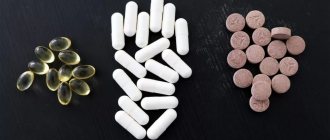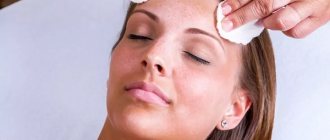What is melanin responsible for in the body?
Have you ever wondered what gives your skin its color or causes discoloration on certain parts of your body? The root cause of all this is melanin, a brown to black pigment found in the skin, hair and iris of the eye.
Melanin is the reason for the variety of skin colors. Additionally, the pigment melanin also acts as a protective layer on the skin, protecting it from damage from ultraviolet rays (UV). The curiosity surrounding melanin stems from its cosmetic, social and protective effects on humans. https://faseb.onlinelibrary.wiley.com/doi/full/10.1096/fj.201701472R
Melanin (from the Greek melas, melanos - dark, black) is a dark brown or black pigment found in hair, skin, as well as in the vascular (including the iris) and retina of the eye. In addition, it is also found in internal organs.
Melanin
- a universal pigment that gives a characteristic shade to the texture of hair, the iris of the eyes and the skin tone of people and animals. It is produced by pigment cells called melanocytes present in the epidermis of the skin, hair, eyes and other parts of the body. Melanin is formed by the oxidation of an amino acid called tyrosine.
Melanocytes are located in the lower layer of the epidermis - these are the cells that produce the brown pigment melanin. This pigment accumulates in keratinocytes and darkens the skin. The process of melanogenesis is responsible for long-term pigmentation, which is designed to protect the epidermis from damage by UV radiation and ensure the functionality of other organs and tissues. In addition, researchers have discovered that melanin plays an important role in the immune system and the health of other vital body systems.
According to natural history research, changes in skin color are an adaptive mechanism. As humans moved through hot environments in search of food, the body had to find ways to cool down. This need for thermoregulation led to an increase in the number of sweat glands and a decrease in the amount of body hair, which in turn made the skin more vulnerable to intense sun, especially in areas near the equator.
Darker pigmentation is like natural sunscreen. Those who lived in colder climates had lighter skin because they experienced lower ultraviolet radiation and needed skin that allowed sunlight to help the body produce vitamin D naturally.
That is melanin
is a natural skin pigment. The color of hair, skin and eyes in humans and animals mainly depends on the type and amount of melanin they have. Special skin cells called melanocytes produce melanin.
We all have the same number of melanocytes, but some people produce more melanin than others. If these cells produce low amounts of melanin, the hair, skin and iris of the eyes can be very light. If cells produce more melanin, hair, skin and eyes will be darker. The amount of melanin produced by the body depends on genes.
When you are in the sun, your body produces more melanin. It helps protect the body from harmful ultraviolet (UV) rays. But this is not enough to completely protect your skin from the sun, which is why it is so important to always use sunscreen.
Research shows that people with darker skin are less likely to experience skin cancer than people with lighter skin. However, more research is needed to see if this is related to the amount of melanin in their skin.
There are 3 types of melanin
:
- Eumelanin
Gives hair, eyes and skin predominantly dark shades. Eumelanin, in turn, can be of 2 types - brown and black. Black and brown hair come from various mixtures of black and brown eumelanin.
Blonde hair indicates that there is a small amount of brown eumelanin present and no black eumelanin.
- Pheomelanin
Colors pinkish parts of the body such as lips. For example, red hair color is obtained with the same amount of pheomelanin and eumelanin.
- Neuromelanin
A dark pigment in the brain that gives color to neurotransmitter cells. It was first described in 1838, but no one then thought it had any function until recent studies showed that loss of neuromelanin is associated with the progression of Parkinson's disease. It is possible that just as melanin protects the skin from damage, neuromelanin protects against cell death.
Melanin and eye color
The amount of pigment in the stroma of the iris determines the color of the eyes. Those with little or no pigment tend to have blue irises. With a little more pigment, eye color is green, while eyes with more melanin are brown. Lighter eyes tend to be more sensitive to sunlight and are at greater risk for other problems, including macular degeneration. In comparison, people with darker eyes may be at higher risk of developing cataracts or glaucoma.
In addition, melanin has many other functions and capabilities.
:
- ensuring the neutralization of free radicals;
- promoting the acceleration of biochemical processes and reactions;
- eliminating the influence of stress factors;
- stabilization of immune function;
- maintaining ideal functioning of the thyroid gland and liver.
We recommend
“Vitamins for veins and blood vessels: nutritional rules for maintaining health” Read more
Melanin production depends on many factors
:
- Genetic composition
: Descendants of different ethnic races and cultures are genetically predisposed to produce a certain amount and color of melanin as an inherited trait.
- Exposure to ultraviolet radiation
: Melanin production is largely dependent on stimulation of melanocytes by ultraviolet light. Melanin acts as a protective shield to prevent skin damage from ultraviolet rays. People exposed to the sun are likely to produce more melanin.
- Melanocyte size
: The size of melanocytes can vary between individuals. This can cause a significant difference in melanin production in an individual.
Why is melanin so important?
Melanin, being the primary determinant of the human races, has been the notorious cause of cruel and indiscriminate actions towards humans since time immemorial. However, revolutionary discoveries in science have revealed the real benefits of melanin. Melanin acts as a natural defense against damage caused by the sun's harmful ultraviolet rays. Ultraviolet exposure is an environmental factor that contributes to the development of skin cancers such as squamous cell carcinoma (SCC), basal cell carcinoma (BCC), and malignant melanoma. Melanin is produced as granules in melanocytes and helps absorb and distribute light energy from ultraviolet rays to protect the genetic material in cells.
Fluctuations in a person's hormonal or genetic makeup can disrupt the production and distribution of melanin and lead to skin diseases such as skin burns and other malignant diseases such as cancer and albinism.
Melanin production can also be affected by certain diseases, such as albinism, which is a genetic disorder in which a person is unable to produce melanin, and vitiligo, which is an autoimmune disease characterized by the progressive loss of melanocytes. People with albinism are vulnerable to skin cancer, especially if their skin is not protected from ultraviolet radiation.
Traditional methods of lightening hair
If you are thinking about how to lighten your hair after dyeing it dark with minimal risk to it, use folk remedies. They are less harmful compared to professional chemical compounds, although they do not act as quickly.
The most effective include:
- Lightening with lemon juice. To prepare a working solution, squeeze the juice of 2 lemons and dilute slightly with water. After washing your hair, rinse your hair with this product. You should not use it for a long time, because lemon juice makes your curls dry.
- Clarification with kefir. To obtain a light lightening effect, you can simply moisten the strands with the product, wrap your head with film, and top with a towel. To make the result more noticeable, you will need a brightening mask. It is prepared from kefir (50 g), vodka (2 tbsp), shampoo (1 tsp), one egg and the juice of half a lemon. The mixture is distributed over washed and dried hair, wrapped in film and a towel. Kefir mixtures are left to act for several hours; it is recommended to do the mask at night and wash it off in the morning.
- Lightening with chamomile. It will take about two weeks to prepare the composition, so this recipe will not help you quickly turn into a blonde. Ingredients: 150 g chamomile flowers, 0.5 l vodka, 50 ml hydrogen peroxide (3%). Dried flowers are poured with vodka and infused for 14 days. Then filter and add peroxide. The tincture is applied to the hair, left to act, and washed off with shampoo.
- Such a familiar remedy as burdock oil also helps to lighten dark hair color after dyeing. Hair should be thoroughly treated with oil, combed and left for long-term exposure (overnight). There will not be a very noticeable effect, but the procedure will have a better effect on the health of the hair. You can do it regularly - gradually your hair will become lighter, stronger and thicker. You can enhance the lightening effect by adding the juice of 1 lemon to the oil.
- Lightening with honey. Before using this product, you need to exfoliate the scalp with a mixture of soda (1 tsp) and fine salt (0.5 tsp) - gently massage the hair roots. After the soda-salt mixture is washed off, apply honey to the hair, leave it for about half an hour, rinse with warm water and dry your hair naturally.
Symptoms, causes and consequences of insufficient melanin
Melanin
is a vital pigment that produces a compound responsible for determining skin and hair color. Melanin deficiency can lead to several disorders and diseases. For example, the complete absence of melanin causes a condition called albinism. Melanin deficiency has previously been associated with various genetic abnormalities and birth defects.
There are almost ten different types of albinism, a condition that is inherited in an autosomal recessive manner. This means that both parents must have carried one copy of the mutated gene, and the offspring must have received two copies.
- Oculocutaneous albinism
A hereditary disease leading to insufficient or complete absence of pigmentation in the skin, hair and eyes. Albinism is more likely to occur when both parents have the recessive genetic disorder, and it can occur to varying degrees in any ethnic group. People with this type of disorder have skin that is highly susceptible to sun damage and cancer, as well as vision abnormalities, including involuntary eye movements and sensitivity to light. Those with albinism should wear sunglasses to protect their eyes and use sunscreen.
- Vitiligo
When certain parts of the skin lose pigment, the result is patches of white (no pigment) skin. Vitiligo is most noticeable in people with darker skin and usually appears between the ages of 20 and 30. Although the reason for the destruction of these specific melanocytes remains unclear, there are three possible patterns of depigmentation
:
- Localized loss of pigmentation
occurs in one or more areas.
- Segmental
- pigmentation is lost on only one side of the body.
- Generalized
- widespread loss of pigment.
- Other types of hypopigmentation
Another cause of hypopigmentation is skin trauma such as burns or blisters. Depending on the extent, melanin loss can be severe. Treatment for this type of hypopigmentation includes the use of concealing cosmetics or corticosteroid creams. The good news is that pigment loss may not be permanent, but it will take time to recover.
Types of hyperpigmentation
Overproduction of melanin is a common condition for all skin types and can occur anywhere in the body. One of the ways it manifests itself is the appearance of sun spots on sun-exposed skin. Treatment can often reduce or remove these mostly harmless spots if they bother a person. Freckles are a hereditary trait that become more noticeable with more sun exposure during the hotter months. Melasma is the presence of brown patches on the skin, especially on the face. It is more common in women during pregnancy because it is triggered by hormones.
Let's note a few more interesting facts about melanin.
- Melanin deficiency appears to be associated with deafness
. For example, in the case of Waardenburg syndrome, most common among the Hopi tribe of North America, loss of pigmentation and deafness occur simultaneously. The prevalence of this syndrome among the Hopi Indians is about 1 in 200.
- The neurodegenerative disorder Parkinson's disease is associated with a lack of neuromelanin in areas of the brain
. This is thought to occur due to a decrease in dopaminergic pigmented neurons, resulting in decreased dopamine synthesis in the brain.
- Nicotine has a high affinity for tissues containing melanin and is a precursor for melanin synthesis
. It has been suggested that this is related to why nicotine addiction appears to be higher and smoking cessation rates lower in people with darker skin pigments.
Study
: Melanin, Melanin
Technologies for lightening dark hair in the salon
Girls lighten their hair not only so that the dark color becomes several tones lighter. This procedure often precedes dyeing strands in other colors - the dye adheres better to bleached hair, and the new shade turns out natural.
There are several types of lightening procedures that beauty salons offer:
- local or complete discoloration;
- highlighting;
- armoring;
- coloring;
- blonde curls.
Hair lightening takes place in several stages:
- The master finds out the client’s wishes and what result she wants to achieve.
- A lightening agent is selected (it must contain caring components).
- The master applies the prepared composition to the hair and distributes it evenly over the entire length.
- The time during which the bleaching substance is on the hair for effect is recorded.
- The composition is washed off with warm running water.
Only until March 7Win guaranteed gifts in March! Discounts on services, photo sessions, as well as the opportunity to pick up the main prize - IPHONE 13 PRO
- The master applies a fixing nourishing balm to the hair.
- After a short period of time, the balm is washed off and the hair is dried with a hairdryer.
- At the client's request, the master styles the bleached hair.
How to increase melanin levels in the body
Melanin is a natural protector against ultraviolet (UV) rays. According to the American Cancer Society, people who have more melanin in their skin have a lower risk of sunburn and skin cancer. Tanning is a sign that the skin produces melanin. This is a way to protect the skin from damage. However, experts have also linked sun exposure, sunburn and tanning to skin damage and skin cancer.
No research has yet proven that food or dietary supplements can increase melanin levels in humans. However, consuming certain nutrients can help protect your skin from UV damage and skin cancer.
- Tanning to Boost Melanin Levels
Although melanin has some protective properties, tanning is not a safe way to increase melanin levels. According to the Skin Cancer Foundation, tanning, sunburn and sun exposure significantly increase your risk of developing skin cancer. Additionally, the Skin Cancer Foundation says people should not try to get a “base tan” before going on holiday or spending long periods in the sun. This pre-tanning does not protect against sunburn, but it increases skin damage and the likelihood of developing skin cancer.
Even though people with darker skin have some natural UV protection, the American Academy of Dermatology says people of all skin tones can get skin cancer and need to protect their skin from the sun.
A healthy diet can also help prevent skin cancer, as certain nutrients may provide some protection against skin cancer. Here are some nutrients that research shows may be helpful in producing more melanin in the body.
- Tyrosine-rich foods
Melanin is formed as a result of the oxidation of the amino acid tyrosine. In addition, tyrosine is also involved in the production of various neurotransmitters that ensure the transmission of nerve impulses. Since tyrosine is a precursor to melanin, including foods that contain tyrosine in your diet, such as eggs, meat, chicken, cheese, turkey, and whole grains, can help increase melanin production in the body. In some cases, tyrosine supplementation may be helpful, but specialist advice is necessary.
- Antioxidants
Antioxidants
are substances that can slow down or prevent cell damage. In some cases, they may help prevent certain types of cancer. Some research suggests that antioxidants may help mediate UV damage to skin and skin cancer. The National Institutes of Health (NIH) suggests that eating more foods rich in antioxidants may help prevent some types of diseases.
While antioxidants in food can be very beneficial, getting them from supplements is a controversial topic. Some evidence suggests that high doses of antioxidant supplements may cause health risks, including an increased likelihood of certain types of cancer. They may also interact with medications.
Study
: The Role of Antioxidants in Skin Cancer Prevention and Treatment, Antioxidants: In Depth
Antioxidants have the greatest potential to increase melanin production. Although more research and high-quality trials are needed, some studies suggest that antioxidants may help. Micronutrients such as polyphenols or flavonoids, which we get from plants, serve as powerful antioxidants and can affect melanin levels. Some may help increase melanin, while others may decrease it.
Consume more antioxidant-rich foods such as brightly colored vegetables, dark berries, dark chocolate and dark leafy greens to get more antioxidants. Taking vitamin and mineral supplements may also help.
- Flavonoids
Flavonoids are nutrients found in almost all fruits and vegetables. These compounds have demonstrated some antitumor properties. One study found that certain flavonoids may help prevent melanoma, the deadliest form of skin cancer. The researchers used several flavonoids, many of which are found in fruits, vegetables and green tea.
While they may not increase the amount of melanin, consuming flavonoids is a great way to help protect your skin from damage.
A person's genetics determines their natural melanin levels and skin color. However, researchers are looking for ways to increase the amount of melanin and help prevent skin cancer. A diet rich in antioxidants and flavonoids is a good way to protect against skin damage and skin cancer.
Additionally, people of all skin tones should protect themselves from UV rays by using sunscreen daily and wearing sunglasses and hats when they are out in the sun for long periods of time.
https://www.fda.gov/radiation-emitting-products/tanning/risks-tanning
- Vitamin A
Researchers suggest that vitamin A plays an important role in the production of melanin and is an important ingredient for healthy skin. We can get vitamin A from food, especially from beta-carotene-rich vegetables such as peas, spinach, sweet potatoes and carrots.
Since vitamin A also acts as an antioxidant, some researchers are of the opinion that unlike any other vitamin, vitamin A may have an effect on melanin production. However, more research is still required to prove this.
We recommend
“Vitamins for skin and hair: content in food and how to take them correctly” Read more
However, claims that vitamin A increases melanin levels are still not reliable. However, some research suggests that taking vitamin A (especially retinol) may be beneficial for overall skin health. For example, according to a 2014 study, a certain type of carotenoids (the substance that gives orange, red and yellow vegetables their color) is found in vitamin A.
You can increase the amount of vitamin A in your body by eating more foods rich in vitamin A, such as fish, meat, and orange vegetables (such as sweet potatoes, carrots, red peppers, tomatoes).
In some cases, supplementation may be necessary. Because vitamin A is a fat-soluble vitamin, it can be stored in the body, which is why the National Institutes of Health recommends a daily intake of 900 mcg for men and 700 mcg for women. For children, the daily intake of vitamin A should be lower.
Eat foods high in beta-carotene and vitamin A. Add orange and red vegetables to your diet, such as carrots, tomatoes, sweet potatoes, zucchini, and red bell peppers, and fruits, such as pumpkin, papaya, and melon.
Carotene does not technically stimulate melanin production, but this fat-soluble pigment will accumulate in the skin, imparting a natural golden glow. The effect of beta-carotene on skin pigmentation appears to be most effective on lighter skin tones. https://academic.oup.com/jn/article/132/3/399/4687282
- Vitamin E
Also a vital vitamin for skin health. It works as an antioxidant and can affect melanin production. While there are no studies directly linking increased melanin to vitamin E, some studies do show that vitamin E may help protect skin from sun damage.
You can increase the amount of vitamin E in the body by eating foods such as grains, nuts, seeds, vegetables, some fruits, asparagus, avocados, and corn.
- Vitamin C
Like vitamins A and E, vitamin C acts as an antioxidant. It can increase melanin production and protect the skin. There are no studies that directly link vitamin C to melanin production. However, some evidence suggests that vitamin C may enhance melanin production.
Consuming foods rich in vitamin C, such as berries, citrus fruits and leafy green vegetables, can increase melanin production. Taking a vitamin C supplement may also be helpful.
We recommend
“Vitamins for vigor: how to take them correctly and their daily dosage” Read more
Foods rich in both vitamin E and vitamin C include green leafy vegetables, tomatoes, berries and broccoli. These products have antioxidant properties, meaning they can help protect the skin from cell damage while promoting balanced melanin production. To get the highest levels of vitamins from fruits and vegetables, try to eat them raw.
Herbal products such as turmeric, green tea and tea tree are high in polyphenoids and flavonoids and may optimize melanin production and help protect the skin. It's worth noting that there are currently no studies directly proving a link between any herbs and increased melanin production. However, there is no harm in trying some herbs that can potentially protect your skin and possibly boost your melanin levels. These herbs can be found in essential oils, dietary supplements, and teas.
- Fatty fish
Increased melanin production reduces the skin's ability to absorb vitamin D when naturally exposed to sunlight. This is an essential vitamin for maintaining healthy bones and blood, so it is important to supplement your diet with foods containing this vitamin.
Include fish such as salmon, catfish, mackerel and herring in your diet. Canned fish such as tuna and sardines are also good sources, as are fish oils, including cod liver oil. Use them sparingly so as not to exceed your total mercury intake.
https://www.ncbi.nlm.nih.gov/pmc/articles/PMC3356951/
Targeted nutrition tips
that will increase your energy level by 10 out of 10
From TOP nutritionists of the MIIN
Get tips
Although some studies may suggest that there are several methods to increase melanin production, they are not completely reliable at this time. However, eating healthy foods or supplements that contain certain vitamins and minerals, such as vitamins A, C and E, can help maintain healthy skin and reduce the risk of developing skin cancer, some studies suggest.
At the same time, there is no convincing evidence that any nutrient or vitamin reliably increases melanin in people. The only sure way to reduce your risk of developing skin cancer is to avoid overexposure to ultraviolet rays and use a high-quality sunscreen.
Side effects of excess melanin
It is worth noting that excess melanin has undesirable consequences
:
- Vitamin D deficiency
Excess melanin can lead to vitamin D deficiency. Vitamin D synthesis is triggered by sunlight as it converts the precursor to its active form. People with excess melanin are more susceptible to vitamin D deficiency because melanin acts as a shield to prevent the absorption of sunlight needed to form vitamin D. It can also cause other diseases such as osteoporosis and rickets.
Vitamin D plays an important role in the absorption of calcium and phosphorus and is also beneficial for maintaining bones and skeletal structure of the body. https://pubmed.ncbi.nlm.nih.gov/28620422/
- Hyperpigmentation
Excessive sun exposure in an attempt to increase melanin levels can lead to hyperpigmentation, causing dark spots, melasma and age spots.
Useful tips for lightening hair
In order not to further injure your hair, before lightening a dark color, you need to assess what condition it is in. If you have recently lightened or dyed your hair, as well as in case of fragility and excessive dryness of the strands, it is advisable to postpone the procedure and treat the hair with masks, balms and other means.
Even with good hair condition, lightening requires preliminary preparation (you need to start about two to three weeks before the planned procedure). We recommend nourishing masks containing olive, burdock, castor, almond, and nettle oils. They should be applied to the roots and distributed along the entire length.
You need to wear the oil mask for about an hour, and then wash it off with shampoo. For prevention, it is enough to make one such mask once a week. To enhance the effect, you can add essential oils (rosemary, ylang-ylang, lemon, fir, cedar) in the ratio: 4 drops per 1 tbsp. a spoonful of base oil.
Of the chemical dyes for lightening hair, cream dyes and bleaching powder have the most gentle effect. Such products have both a brightening and toning effect. However, they are not able to 100% rid hair of melanin. Yes, it is possible to get a shade several shades lighter than the original one, but you won’t be able to transform from a brunette to a blonde.
What foods contain melanin?
Over time and with age, the amount of pigment in the body may decrease. Therefore, a person may experience spots on the skin and gray hair. A harmonious and balanced diet, including healthy foods to increase melanin production, will help maintain health.
For the synthesis of melanin, it will be useful to maintain a healthy lifestyle, with walks in the fresh air, exposure to the sun for the optimal amount of time per day, and moderate physical activity. Let's talk in more detail about products that affect melanin production.
Foods that support melanin production
:
- Animal products
. They contain copper and protein, which are necessary for the production of pigment.
- Cereals, legumes and greens
. Rich in vitamins A, E, B, which promotes better absorption of beneficial components from food.
- Orange fruits and vegetables
contain a large amount of carotene, which gives the fruit a rich color and also increases the amount of melanin produced.
- And other groups of products that support melanin production, but in smaller quantities. For example, nuts, some fruits and vegetables, leafy crops
.
Table of foods to support melanin production.
| Category | Name |
| Animal products | Beef, dairy products (cheese, cottage cheese, milk), seafood (mussels, oysters, clams, lean fish, seaweed), turkey, offal (liver, kidneys) |
| Cereals, legumes, greens | Sesame, pumpkin seeds, beans (soybeans, beans, lentils, peas, chickpeas), grain products and any types of cereals (mainly buckwheat, oatmeal, rolled oats), lettuce, spinach, celery, dill, parsley, green onions |
| Orange fruits and vegetables | Pumpkin, carrot, apricot, melon, peach, persimmon, tangerine, orange |
| Nuts | Peanuts, almonds, hazelnuts |
| Other fruits | Bananas, avocados, coconuts |
| Other vegetables | Cabbage, beets + leafy crops with dark shades |
Rules for consuming foods containing melanin
As with other products, everything needs moderation. Any food in excess will not lead to anything good. Of primary importance, as always, will be the nutritional value and variety. Add foods from our table to your diet, experiment, but don’t forget about the rational basics of nutrition: nutritious meals, water regime, enough fiber, healthy fats, complete protein. Before getting the nutrients you need from supplements, unless you have serious deficiencies, try to get them by working on your diet.
Reasons for increased melanin levels
Hyperpigmentation
- the process of oversaturation of certain areas of the skin with coloring pigment.
Causes
:
- natural aging of the body;
- hormonal changes as a result of menopause, pregnancy or taking hormonal medications;
- liver dysfunction;
- thyroid diseases.
Symptoms of excess melanin in the body
:
- birthmarks
– look like blurry spots of different diameters and shapes, colors – black, light beige, dark brown;
- freckles
– closely spaced small spots of dark and light brown tones.
- dark spots
– formed on clean skin or at sites of injury spontaneously or under the influence of external harmful factors, color – dark;
- moles
– a skin defect of an oval or round shape, the shade ranges from black to brown.
What foods reduce melanin levels?
There are a number of products that, on the contrary, reduce pigment production. If such food is regularly present in the diet, the level of melanin decreases sharply. People who want a nice, even tan should avoid consuming these products while on holiday.
- too salty crackers, which are consumed with beer, chips and peanuts, pickles and salty foods;
- sweet pastries, cakes, pies, buns, ice cream, candies, marmalade, marshmallows, waffles and cookies;
- alcohol, especially wine, martini, cognac, rum, aperitif, vodka and other alcoholic drinks;
- carbonated drinks, strong coffee and tea;
- boiled corn.
We recommend
“Carbohydrate deficiency: signs and causes” Read more
Melanin pigment can be reduced through home treatments, in-clinic treatments and home remedies. Many people use kitchen ingredients to reduce melanin in the skin, but it's worth noting that there is no scientific evidence for these methods.
- Potato
Potatoes contain an enzyme called catecholase, which reduces the level of melanin in the skin. Potatoes are an excellent antioxidant that help the skin get rid of oxidative stress.
- Lemon
Lemon contains alpha hydroxy acid, which exfoliates the top layer of skin containing melanin. Lemon is a natural bleaching agent.
- Tomatoes
Tomatoes have many benefits for the skin. One of them is their ability to inhibit the enzyme tyrosinase, which helps in the synthesis of melanin. They also have anti-inflammatory and anti-aging properties.
However, you must understand that melanin depends not only on food, but also on genetics. It is impossible to change genetic factors, but a properly formulated diet can increase the concentration of melanin and, therefore, avoid the appearance of gray hair and age spots.
Whiten or lighten? What's the difference?
Depigmenting cosmetics can be whitening or brightening. These two words are not synonymous; they differ not only in sound and spelling, but also in meaning.
Whitening cosmetics work at the stage of pigmentation formation. It acts on the synthesis of melanin and its transport to the epidermis. Lightening cosmetics correct an already formed pigment spot.
Obviously, depigmentation treatment will be most effective when it uses both of these effects. Read more about the features of the choice - Whitening cream for age spots on the face.











